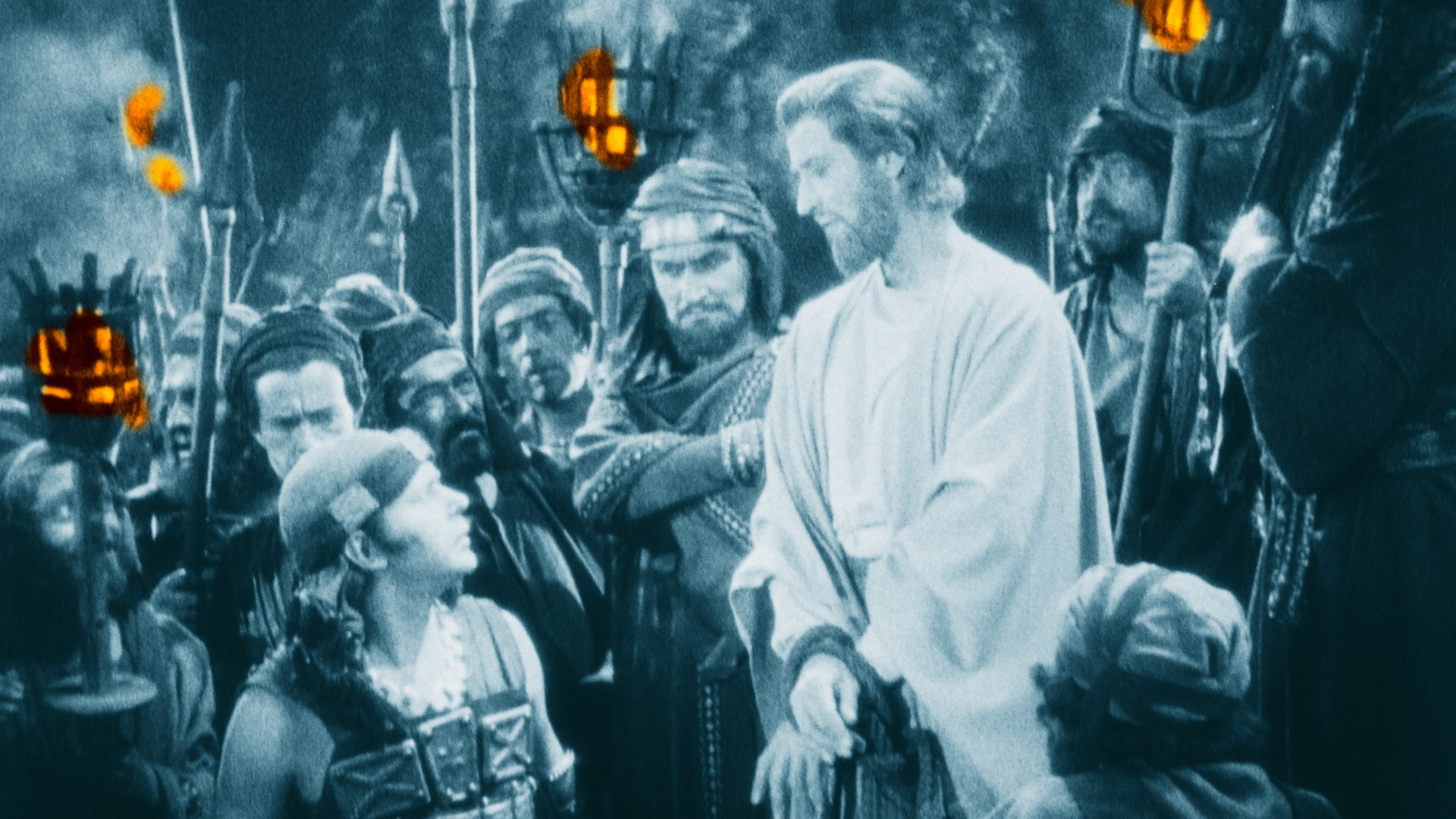Jesus of Nazareth is trending. The fifth season of The Chosen—the first multi-season series about Christ and the disciples—is about to drop on Prime Video. The King of Kings—a Korean animated feature released in the US via Angel Studios—is now streaming on video on demand after grossing $66 million in theaters. Mel Gibson is gearing up to shoot his sequel to The Passion of the Christ in Rome’s Cinecittà Studios this summer. And Terrence Malick is in post-production on The Way of the Wind, which features Jesus as a main character. (Alas, Martin Scorsese’s The Life of Jesus, an adaptation of Shūsaku Endō’s biblical novel, has been postponed indefinitely.)
The popularity of Christ as a screen subject is a matter of record—according to Guinness World Records, he is the fourth-most-portrayed character in film (behind the Devil, Santa Claus, and the Grim Reaper!). What is less understood is that all these representations are descendants of the first mainstream Hollywood retelling of Jesus’ life and ministry: the 1927 silent epic The King of Kings. The domestic Blu-ray debut of Cecil B. DeMille’s seminal blockbuster provides a convenient opportunity to revisit the defining Jesus film of the 20th century.
Before movies could talk, Jesus attracted the attention of some of the world’s most successful film artists. Alice Guy—the first woman to direct a movie—refashioned the Passion play into a series of striking tableaux for her 1906 production, The Birth, the Life and the Death of Christ. A decade later, D. W. Griffith dramatized the persecution and death of Jesus as one of four parallel story lines in his magnum opus Intolerance.
Introducing Jesus to a new generation of moviegoers was a task Cecil B. DeMille undertook with the utmost sincerity. The autocratic 46-year-old director had risen to the top of Hollywood after a series of sophisticated boudoir comedies, the popularity of which led to the formation of his own production company. His 1923 drama The Ten Commandments represented his first foray into biblical adaptation, though it is properly understood as a modern melodrama featuring an extended prologue about Moses and the Egyptians.
DeMille showed interest in an adaptation of the Genesis flood narrative but abandoned the idea once he learned that Warner Bros. was preparing Noah’s Ark, a production that would soon become notorious for the accidental deaths of three extras during the shooting of the climax. Presented with the idea of fashioning a large-scale retelling of the life of Christ, DeMille turned to his trusted scenarist Jeanie MacPherson to develop what he hoped would be, in his own words, “the greatest love story ever told.”
In separate biographies, writers Robert S. Birchard and Scott Eyman each recount, in amusing detail, the making of The King of Kings. From the start, DeMille’s goal wasn’t merely to entertain the masses but to educate them. (The opening title card explicitly situates the film within the context of the Great Commission.) He took pains to present the gospel narrative in a way that would not offend sensitive viewers and was especially careful in his depiction of the Jews, laying the blame for Christ’s death on certain individuals—namely Judas and Caiaphas—rather than an entire people group.
DeMille was also acutely aware that poor behavior from his cast and crew during production could translate into a public relations nightmare, and he strictly forbade foul language, blasphemy, and smoking on set.
For the title role, DeMille chose H. B. Warner, an English-born actor whose stage and screen career had been waning. (Contemporary viewers might know him best as Mr. Gower, the pharmacist who slaps young George Bailey in It’s a Wonderful Life.) At 50 years old, he was certainly among the most mature of all onscreen Christs. Fine-boned with warm, interrogating eyes, Warner exudes a graceful physicality, and while his movement comes across as stylized and theatrical, he still looks “right” for the role. DeMille was fully aware that this performance would be taken as the definitive screen portrait for a generation. “The visual impression of Jesus is going to be planted in the minds of people by the man who plays Jesus in this picture,” he said.
Filming lasted several months—the crucifixion scene alone took two weeks, wrapping on Christmas Eve—and cost a reported $2 million, though the budget was likely inflated, with funds diverted to keep DeMille’s flagging studio afloat. But the movie became the third-most-popular release of 1927—behind Wings (the first Oscar winner for Best Picture) and The Jazz Singer (the film that ushered in “talkies”). Despite DeMille’s attempts to circumvent charges of antisemitism in his depiction of the Pharisees, the Jewish press objected to the portrayal of Caiaphas as a money-grubbing Christ killer, which led Paramount to re-edit the film for general release. (Both versions are available today.)
To watch The King of Kings in 2025 is to appreciate that silent film has a language and syntax of its own. Jesus’ first appearance, his face gradually coming into focus as a young girl’s sight is restored to her, is an exercise in radical subjectivity that puts the viewer on the receiving end of a miracle. The addition of spoken dialogue—if it were technically feasible at the time—would have been a distraction, shattering this delicate reveal.
The sequence is followed shortly after by a scene in which Mary Magdalene is cleansed of her demons, each personified as one of the seven deadly sins and rendered ghostly through double exposure. Such bold stylistic choices demonstrate the primacy of visual storytelling and give credence to critic Susan Sontag’s observation that “with the coming of sound, the image making lost much of its brilliance and poetry.”
In the 1920s, as more light-sensitive panchromatic film stock became available, “soft style” cinematography began to change the look of films. Throughout The King of Kings, Christ is depicted as a being of light, emphasized by the translucent glow that emanates from his snow-white tunic. Taking John 8:12 literally, his skin seems to emit a supernatural radiance, and the bright band of light that appears around his face and head—achieved by a photographic effect called, appropriately enough, a halo—turns him into a living fresco.
If the very nature of film depends upon light, what better subject than the Light of the World? In The King of Kings, the beauty of Christ and the beauty of silent film meet on an exalted plane of cinema art.
Ironically, DeMille’s intensely pictorial rendering of the Gospels has the effect of making the plot—the actual scene-by-scene progression of the story—feel heavy and plodding, which explains why the film could be a tough sell for the distracted contemporary viewer. The Chosen relies as much on dialogue as DeMille’s film does on visuals, and is therefore much friendlier, more digestible, to a modern audience.
For its time, however, The King of Kings was considered quite modern. As Stephenson Humphries-Brooks notes in his survey Cinematic Savior, DeMille’s Jesus is directly addressing the sins and excesses of a decadent America still in the thrall of the Jazz Age. The final image—in which the risen Christ, ascending into heaven, hovers over a modern industrial skyline—bends time and space to remind viewers that the Lord is as present in the here and now as he was in ancient Judea.
Nearly a century has passed since The King of Kings premiered at Grauman’s Chinese Theatre. What will audiences make of it nearly a century later? Flicker Alley’s new Blu-ray release, which showcases a recent restoration by Blackhawk Films, a new score by Robert Israel, and a host of bonus material, calls for a fresh assessment. The luxurious two-color Technicolor sequences have been burnished to a brilliant finish. (The Resurrection alone is apt to widen a few eyes with its lustrous red and green hues.) It supplies yet more evidence—as if any more were needed—that art can sometimes take us, as Aleksandr Solzhenitsyn put it in his Nobel Prize acceptance speech, into a realm “beyond words.”
Nathaniel Bell manages the internship program and teaches film history for the Snyder School of Cinema & Media Arts at Biola University. He lives in Whittier, California, with his wife and three sons.

















